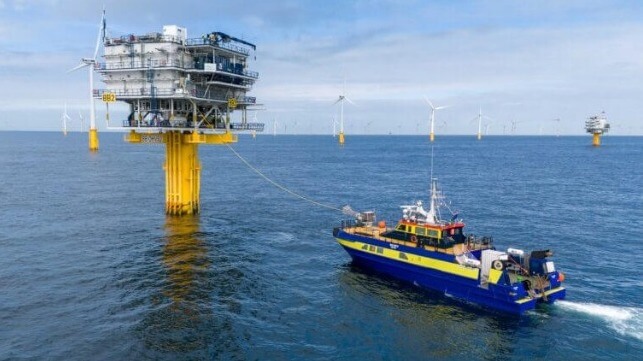Offshore Charging System for Service Vessels Tested at Belgian Wind Farm

Parkwind, a developer of offshore wind farms owned by Japan’s JERA, completed the first test of an offshore charging station that supplies power from the wind farm to service vessels. The technology which is being developed by several companies holds the promise to permit crew and maintenance vessels to operate using renewable energy coming from the wind farm.
Proponents of the concept highlight it will make possible the use of electric powered emission-free vessels to support the wind farms. One of the current challenges is that as wind farms move further offshore they are beyond the storage capacity of current batteries to safely operate the vessels.
The system which was developed by UK-based MJR Power & Automation, was tested at the Nobelwind wind farm located approximately 30 miles from shore in the Belgian North Sea. The wind farm has been in operation since 2017 and consists of 50 turbines.
The charging system was transported to the offshore substation aboard one of the CTVs and lifted in modules using the substation crane. Within two days, it was assembled, hooked up, and commissioned on the substation. The setup was successfully tested, achieving the first transfer of power to a CTV from a fully operational and producing offshore wind farm.
“This is a game changer for our maintenance vessels, which can now access green energy direct from our wind turbines as they carry out their work,” said Kristof Verlinden, Head of O&M at Parkwind. "The trial proved the system can transfer electricity from a wind farm to the vessels safely without any disruption to the farm.”
Parkwind points to the ease of use of the system which has an automatic coupling and uncoupling process. It allows ships to connect to the charging cable and stay in place while charging, despite sea currents.
MJR carried out all electrical and mechanical interface engineering to install the system on the substation. Parkwind provided offshore logistics, offshore installation, testing support, and the electrical power interface.
The system is designed for both CTV charging up to 2MW and SOV charging up to 8MW. It can also be used for supplying offshore power to other conventional offshore vessels on standby, also reducing their emissions from diesel generators.
MJR says it will now incorporate the lessons learned from the trials into the first commercial offshore charging system delivery scheduled for Q1 2025.
No comments:
Post a Comment